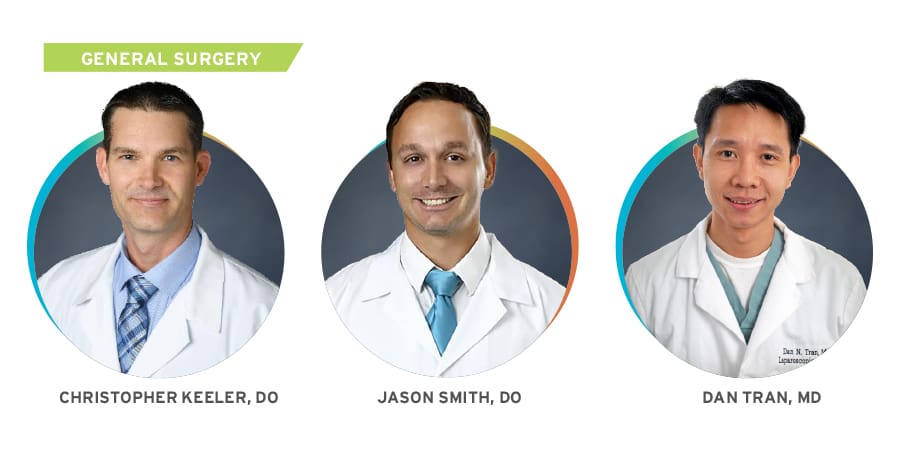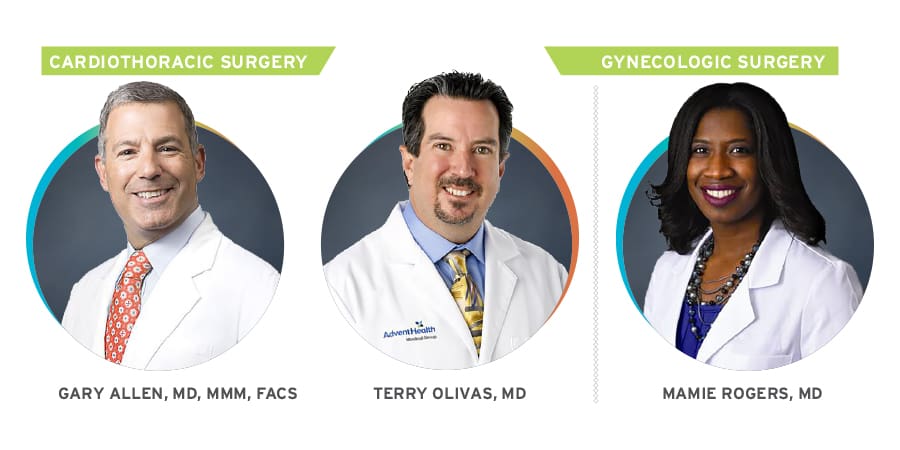
By Akers Editorial
Health Pros: Robotic-Assisted Surgery at AdventHealth Waterman

Precision robotics offer enhanced patient benefits and set AdventHealth Surgical Program apart.
We live in remarkable times. Medical advancements that once sounded like science fiction have become routine—especially in the operating room.
Robotic-assisted surgery is the latest advancement to upend the status quo and provide patients with an array of benefits over traditional surgery. While patients have come to expect it, not every hospital offers it.
AdventHealth Waterman is one of the few programs in Florida offering advanced robotic technology for specialized procedures like heart surgery and revascularization. Waterman also features multiple robotic-assisted operating rooms for various surgical procedures.
“We have the most robotic technology in Lake County and are well equipped for all types of surgery where robotics is an option,” says Christopher J. Keeler, DO, a board-certified general surgeon with AdventHealth.
“This technology was sorely needed in our market. We launched our robotics program using the da Vinci® Surgical System in August 2022, and within a year had done more than 363 robotic surgeries,” says Dr. Keeler.
With two da Vinci® Surgical Systems in use and a third coming in early 2025, there are currently six AdventHealth surgeons using them in Tavares. Robotic-assisted surgery is available for cardiothoracic, general, gynecological, and urological surgical procedures.
Pioneering Technology
Most people have heard of laparoscopic surgery, which uses a camera (scope) and requires smaller incisions than traditional surgery. Robotic-assisted surgery adapts this same minimally invasive platform but with even more advantages for both patient and surgeon.The surgeon performs the operation from a bedside console computer station using hand controls to direct the robot’s maneuvers within the operating field.
“The robotic optics are 3D and magnified 10 times, which helps us clearly see all the fine qualities and layers of the tissues and structures we’re operating on,” says Dr. Keeler. “We’re still using a camera and making small incisions, but an advantage with robotics is that it minimizes the number of people in the operating room.”
Using the Da Vinci’s robotic arms and instruments, the surgeon can work from angles and positions that would otherwise be difficult to access. The surgeon controls the robotic arms, which are steadier than human hands.
“The da Vinci has taken what was already established in the surgery world, including laparoscopic camera technology, and made it better,” says Dr. Keeler.
Patient Benefits
Patients benefit from the precision of robotic-assisted surgery for hysterectomies, gall bladder removal, prostatectomies, tubal ligation, cystectomy, kidney removal and transplants, joint replacements, mitral valve repair and more. When compared with traditional surgery, robotic-assisted surgery offers numerous advantages, including:
Game Changer
Gary Allen, MD, MMM, FACS, has been a cardiothoracic surgeon for 24 years and now performs robotic-assisted heart surgeries at AdventHealth Waterman. These include the usual portfolio of adult cardiac cases, such as bypass, valve repair and replacement, aneurysms, and atrial fibrillation surgery.
“The results have been excellent,” says Dr. Allen, noting that only three other programs in the state are using this innovative technology in their cardiac surgery program.
He says the new technology is a game changer.
“This is truly minimally invasive. We’ve gone from traditional open-heart surgery with a 10-inch incision in the breastbone to two to three small incisions under the left breast,” explains Dr. Allen.
“With traditional surgery the patient still has the breathing tube in for a few hours after surgery. With robotics, the breathing tube comes out right at the end of surgery. Typically, patients who have surgery in the morning are walking around in the afternoon. It’s just one more advantage that the patient is breathing on their own and moving earlier,” he adds.
Dr. Allen notes that, on average, patients return home two to three days post-surgery, as compared to five to seven days with traditional surgery.
Patients with jobs that are not physically demanding are generally back to work within two weeks. Even people with jobs requiring physical exertion usually return to work sooner than with traditional cardiac surgery. This is true for most robotic-assisted surgeries.
“For the first time in my career, I’ve had to write letters saying a patient could go back to work earlier than expected,” says Dr. Allen.
Meet Our Expert Team
“We have a good commitment from AdventHealth to make sure this technology is uniform through all our hospitals. We’re committed to our patients and the community to further advance their healthy lifestyles,” says Dr. Keeler.
The skilled team of board-certified AdventHealth Medical Group surgeons performing robotic-assisted surgery at Waterman includes:


“Contact us to determine if you’re a candidate for robotic-assisted surgery,” advises Dr. Allen. “Not every patient is a candidate, but a short screening call or office visit can help determine if robotic surgery is best for you. New patients are generally seen within 48 hours.”








